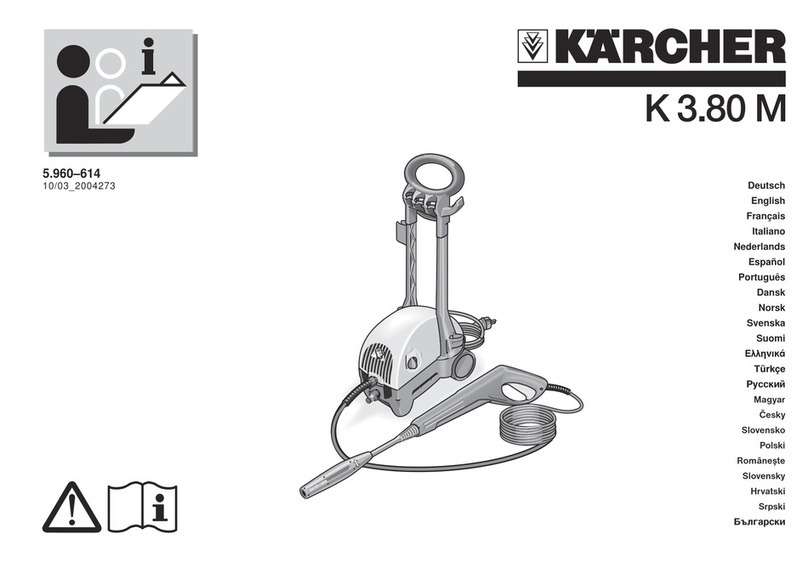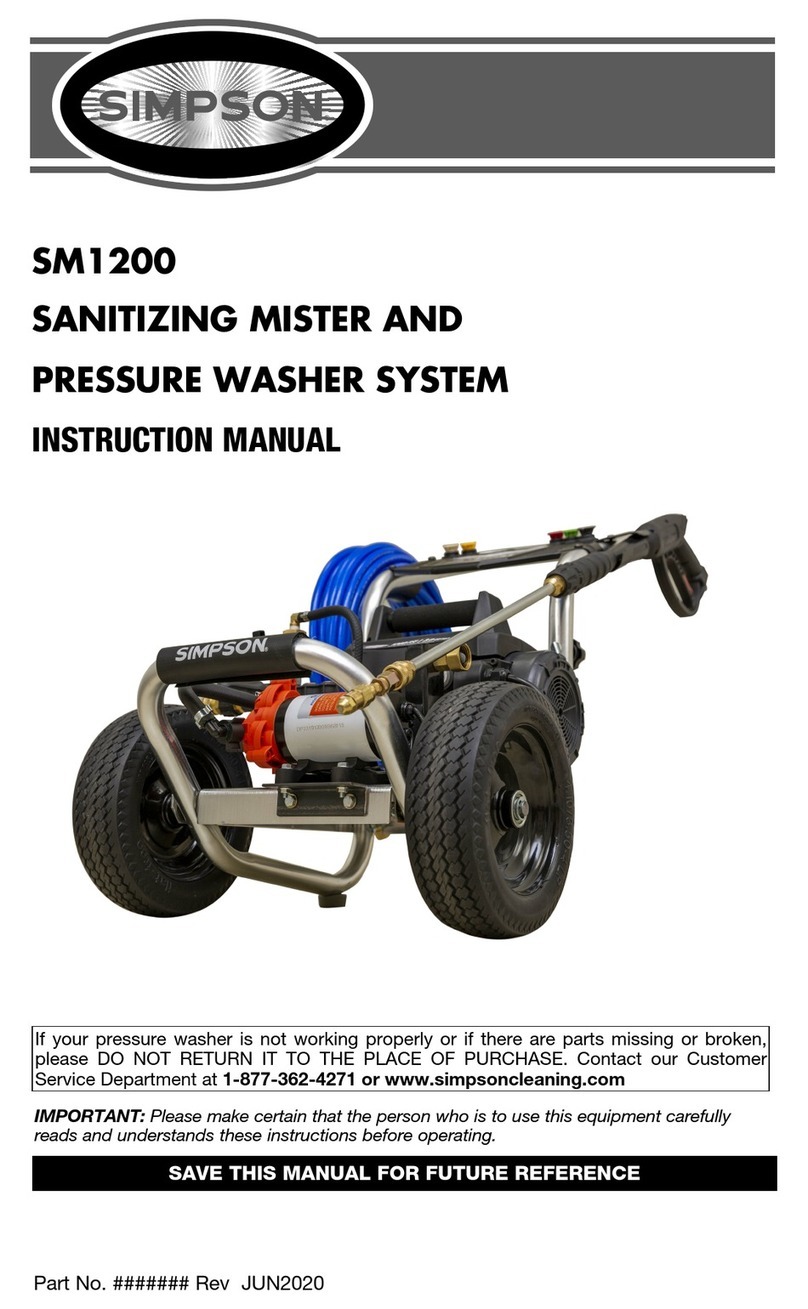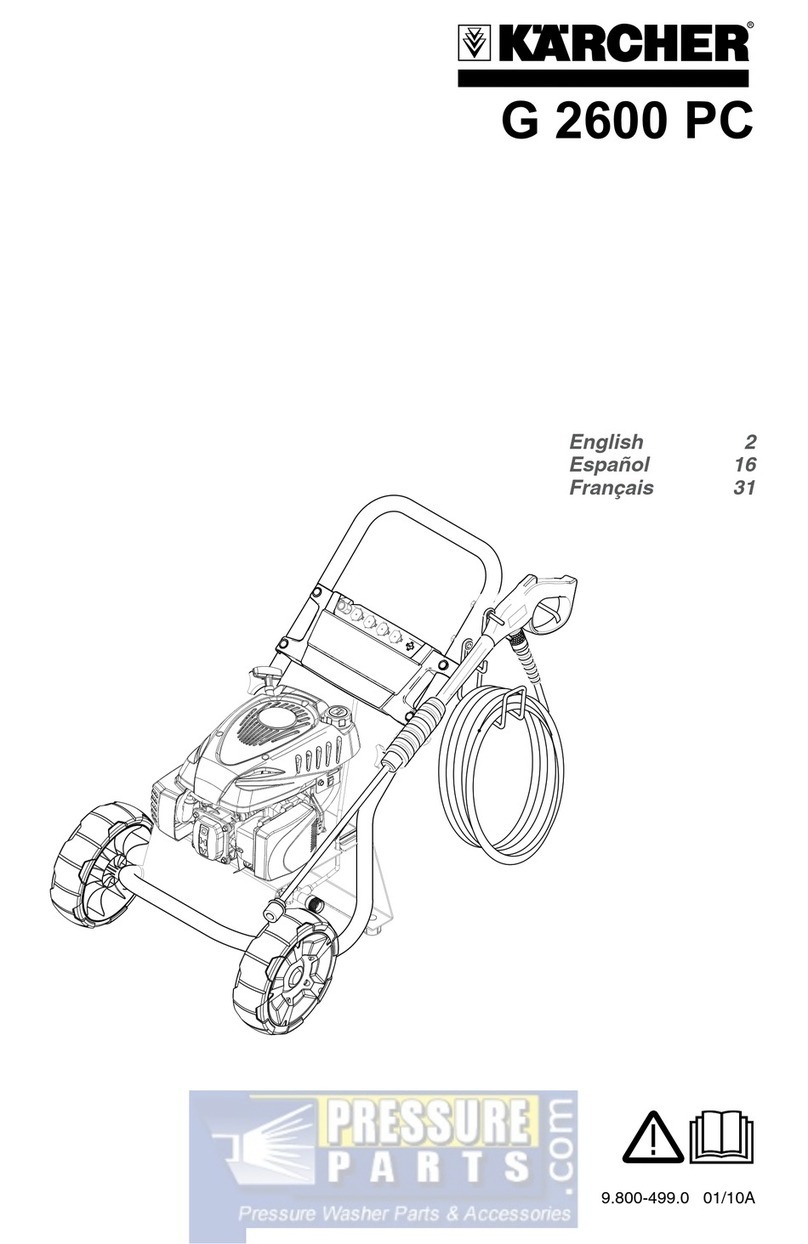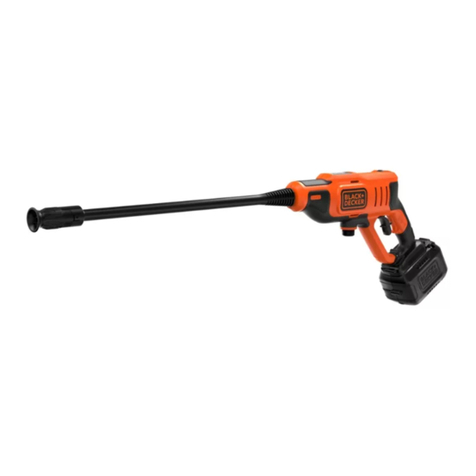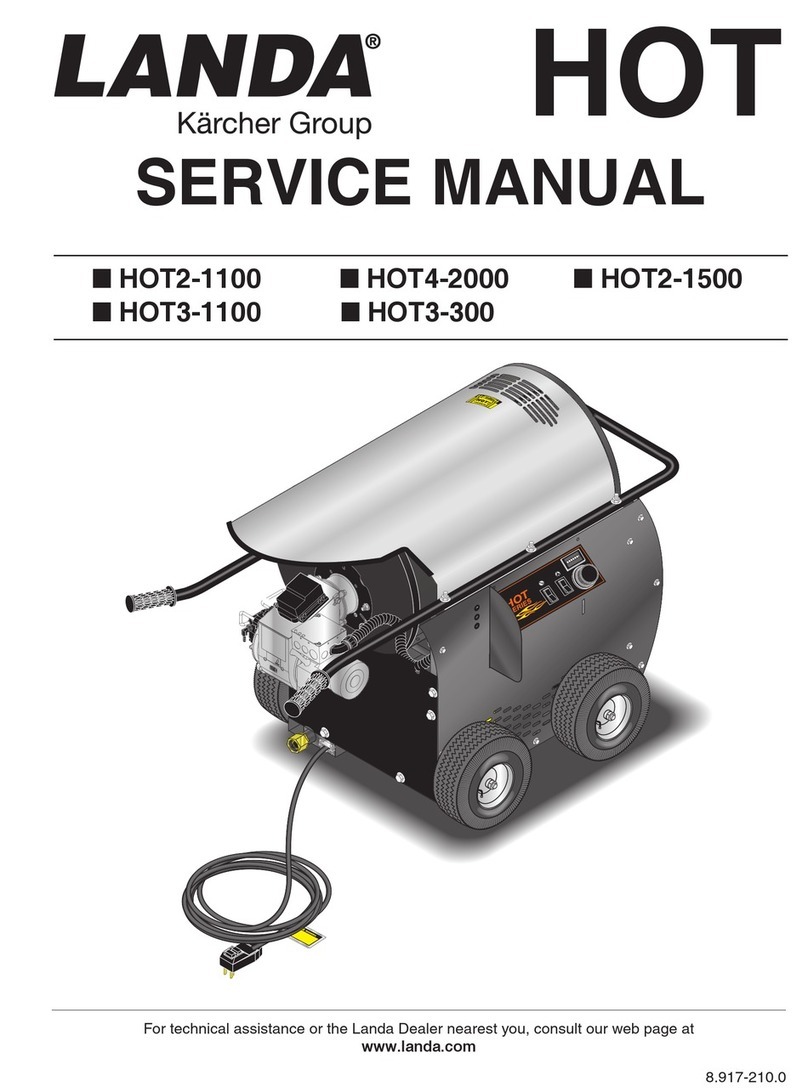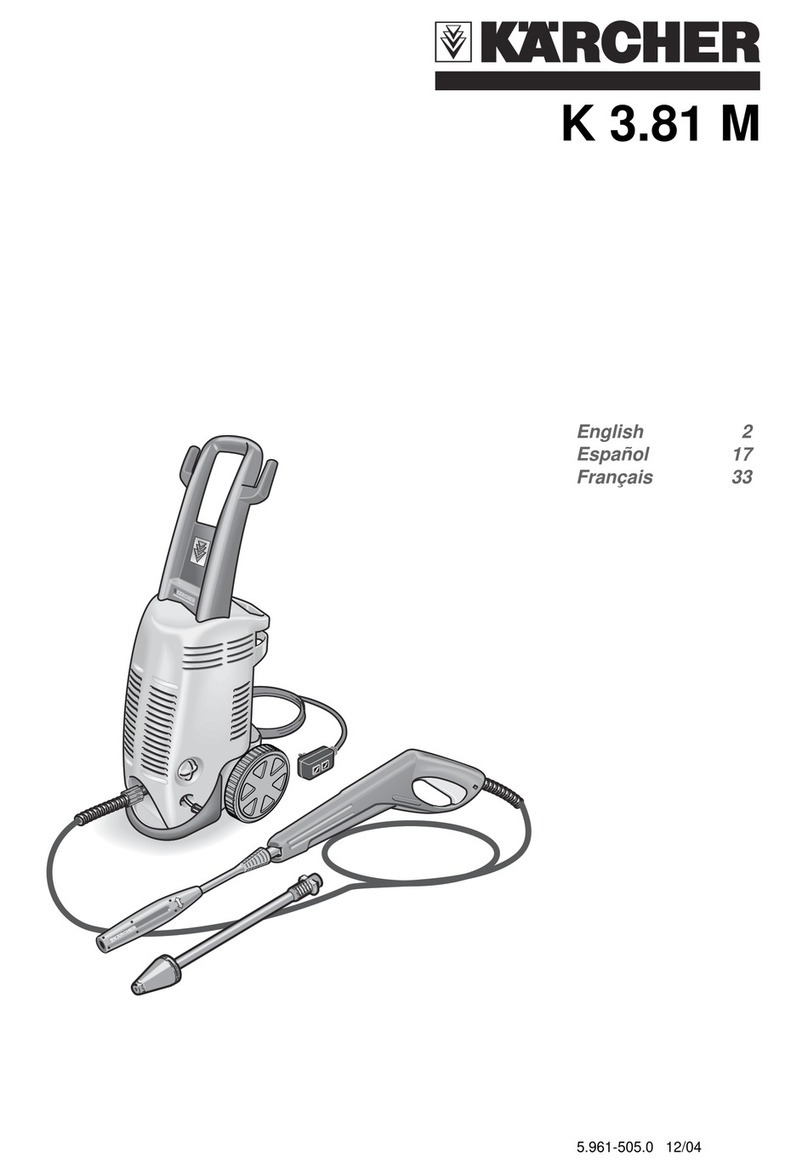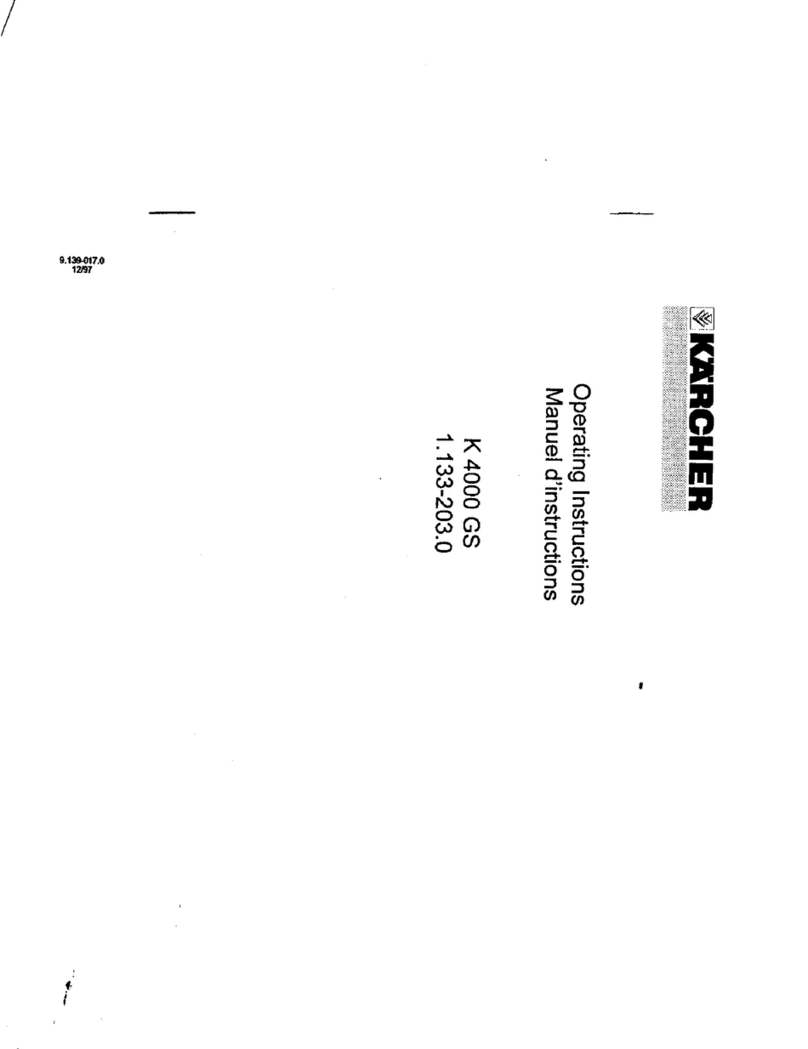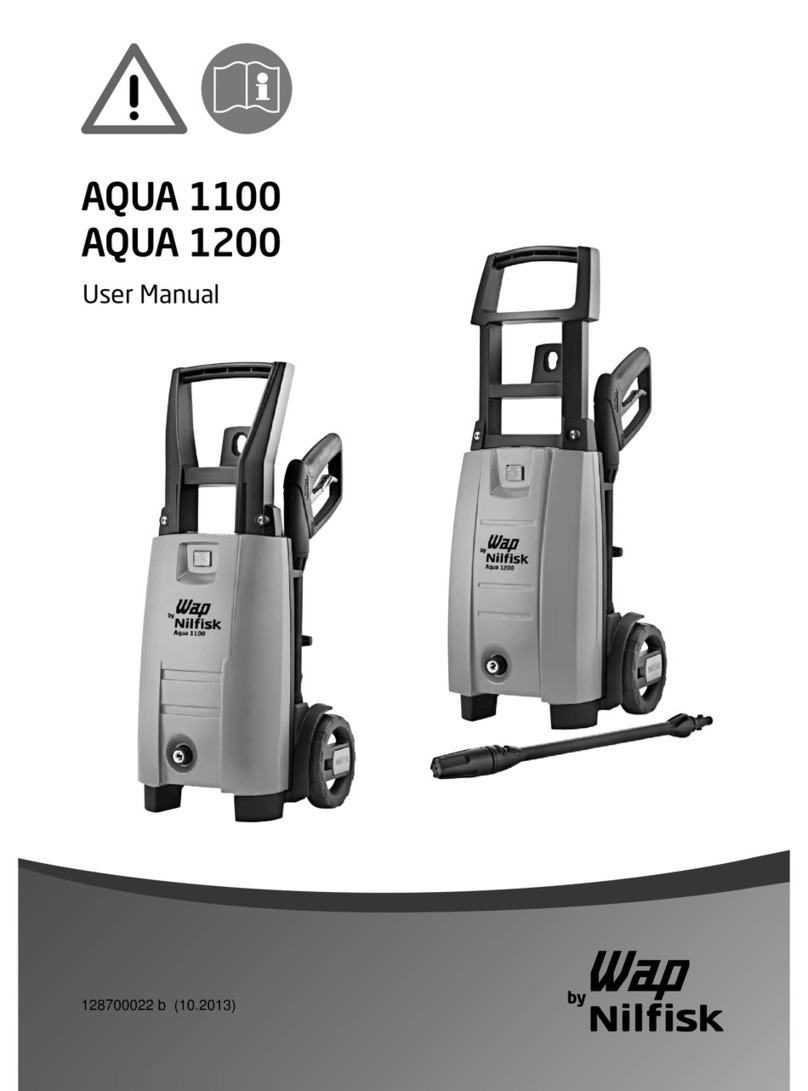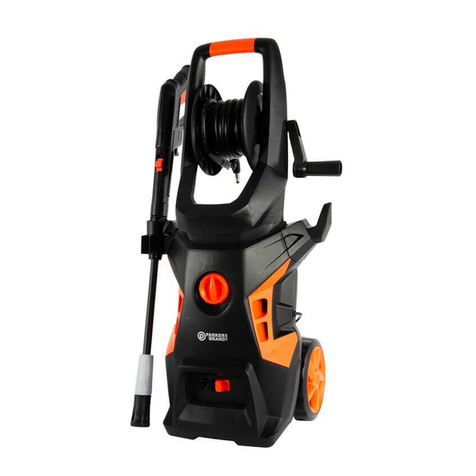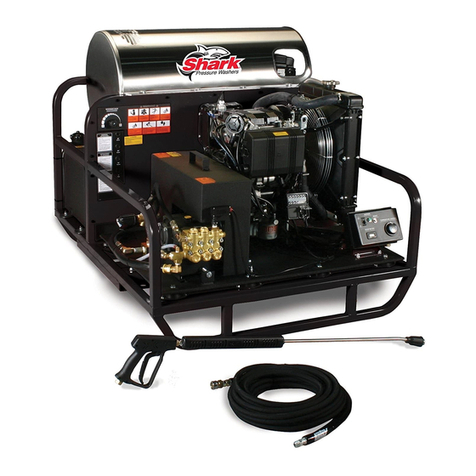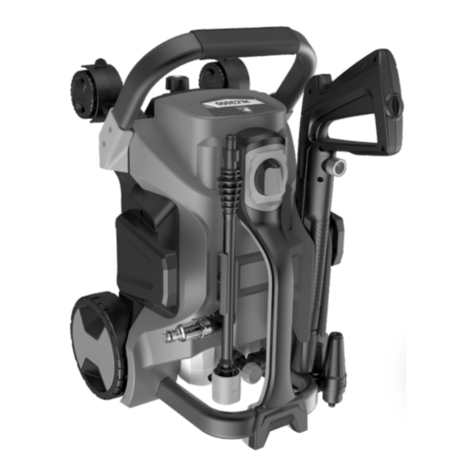Rockworth AO680/1400 User manual

Fig.1
`
Fig.5
Fig.3
Fig.2
Fig.4
1
11
4
3
5
6
213
10
14
8
7
9
12
15
120BAR • 1500W
HIGH PRESSURE WASHER
AO680/1400

Fig.6
1. Technical data
Model. No AO680/1400
Rated voltage: AC230V 50Hz
Rated input power: 1500W
Protection class II
Degree of protection: IPX5
Rated pressure: 8MPa
Max. pressure: 12MPa
Rated flow: 6.0 l/min
Max. flow: 7.2l/min
Rated temperature: 0-40℃
Max. inlet pressure: 0.7MPa
Sound pressure level:
LpA=75.9 dB(A)
KPA=3dB
Sound power level:
LwA=90.4dB (A)
KWA=3dB
Guaranteed : LwA=92dB (A)
Vibration value αh=3.2m/s2
Kαh=1.5m/s2
Net Weight : 5.7kgs
Gross Weight: 6.3kgs
Fig.11
Fig.14
Fig. 10
Fig.12
Fig.7
Fig.8 Fig.9
Fig.13

2. SYMBOLS USED TO MARK INSTRUCTIONS
Some of the following symbols may be used on this product. Please study them and learn their
meaning for safe operation.
SYMBOL NAME EXPLANATION
Read instruction
Before starting up your high pressure washer
for the first time, this instruction manual must
be read through carefully. Save the
instructions for later use.
Safety Alert Safety instructions marked with this symbol
must be observed to prevent danger to
persons.
Safety mark This symbol is used to mark safety
instructions that must be observed to prevent
damage to the machine and its performance.
Indication mark This symbol indicates tips and instructions to
simplify work and to ensure a safe operation.
Waste products
disposal
Waste electrical products should not be
disposed of with household waste.
Please recycle where facilities exist.
Check with your Local Authority or retailer for
recycling advice.
Eye Protection Always wear safety goggles or safety
glasses with side shields or a full face shield
when operating this product.
Class II
Construction Double-insulated construction.
keep
Bystanders
Away
To reduce the risk of injury, user must keep
all bystanders at least 15m away.
Electric Shock
Precaution Remove plug from the mains immediately if
cable is damaged or cut.
Sound power
level Sound power level is 96dB(A)
Electrical shock
hazard Electrical shock hazard
Machine not suitable for connection
to the potable water mains
The following signal words and meanings are intended to explain the levels of risk
associated with this product.
SYMBOL SIGNAL MEANING
Danger Indicates an imminently hazardous situation which, if not
avoided, will result in death.
Warning Indicates a potentially hazardous situation which, if not
avoided, could result in death or serious injury.
Caution Indicates a potentially hazardous situation which, if not
avoided, may result in minor or moderate injury.
Caution (Without Safety Alert Symbol) Indicates a situation that
may result in property damage.
3. IMPORTANT SAFETY INSTRUCTIONS
WARNING!
This appliance is not intended for use by children or other persons without assistance or
supervision if their physical, sensory or mental capabilities prevent them from using it safely.
Children should be supervised to ensure that they do not play with the appliance.
Before starting up your machine please check it carefully for any defects. If you find any, do not
start up your machine and contact your distributor.
Especially check:
_ The insulation of the power cord should be faultless and without any cracks. If the power cord
is damaged, an authorized distributor should replace it.
WARNING!
Warning: Do not use this appliance without reading this instruction sheets.
- The electric supply connection shall be made by a qualified electrician and comply with
IEC60364-1.
- The Electric supply to this appliance should include either a residual current device that will
interrupt the supply if the leakage current to earth exceeds 30 mA for 30 ms or a device that
will interrupt the earth circuit.

- WARNING: This appliance has been designed for use with the cleaning agent supplied or
recommended by the manufacturer. The use of other cleaning agents or chemicals may
adversely affect the safety of the appliance.
- WARNING: Do not use the appliance within range of persons unless they wear protective
clothing.
- WARNING: High pressure jets can be dangerous if subject to misuse. The jet must not be
directed at persons, live electrical equipment or the appliance itself.
- Do not direct the jet against yourself or others in order to clean clothes or foot-wear.
- Risk of explosion – Do not spray flammable liquids.
- Disconnect from the electrical power supply before carrying out user maintenance .
- High pressure cleaners shall not be used by children or untrained personnel.
- To ensure appliance safety, use only original spare parts from the manufacturer or approved by
the manufacturer.
- WARNING: Water that has flown through backflow preventers is considered to be non-
potable.
- WARNING: The machine shall be disconnected from its power source during cleaning or
maintenance and when replacing parts for mains operated machines by removing the plug from
the socket-outlet;
- WARNING: High pressure hoses, fittings and couplings are important for safety of the appliance.
Use only hoses, fittings and couplings recommended by the manufacturer.
- Do not use the appliance if a supply cord or important parts of the appliance are damaged, e.g.
safety devices, high pressure hoses, trigger gun.
- WARNING: If an extension cord is used, the plug and socket must be of watertight construction.
- WARNING: Inadequate extension cords can be dangerous.
_ This high pressure washer must not be used at temperatures below 0°C.
WARNING!
- Cord on drums should always be completely unwinded to prevent the cord from overheating. -
If an extension cord is used, the plug and socket must be of watertight construction.
- Inadequate extension cords can be dangerous.
- comply with the below-mentioned requirements for length and cord dimensions.
1.0 mm² max. 12.5 m
1.5 mm² max. 20 m
2.5 mm² max. 30 m
Power cord connections should be kept dry and off the ground.
_ If the power cord is damaged, it must be replaced by the manufacturer or his service agent or
similarly qualified person in order to avoid a hazard.
All keep the machine on a stable and flat surface during operation, handling, transportation and
storage. Sudden overturn of machine will cause injury to body.
In the event of accident or breakdown, switch off the machine immediately. (e.g. contact with
detergent: rinse with an abundance of clean water)
Attention!
Through poor conditions of the electrical MAINS, shortly voltage drops can appear when
starting the EQUIPMENT. This can influence other equipment (eg. Blinking of a lamp). If the
MAINS-IMPEDANCE Zmax < 0.335 OHM, such disturbances are not expected. (In case of
need, you may contact your local supply authority for further information.)
WARNING! ELECTRICAL SHOCK HAZARD
Improper connection of the equipment-grounding conductor can result in a risk of electrical
shock. Check with a qualified electrician or service person if you are unsure if an outlet is
properly grounded. DO NOT modify the plug provided with the appliance to fit an outlet, have a
proper outlet installed by a qualified electrician.
Mains power connection
The following should be observed when connecting the high pressure
washer to the electric installation:
_ The electric installation shall be made by a certified electrician and comply with IEC-364.
_ It is recommended that the electric supply to this appliance should include either a
residual current device that will interrupt the supply if the leakage current to earth exceeds 30 mA for
30 ms.
IMPORTANT! Only use water without any impurities.
If there is a risk of running sands in the inlet water (i.e. from your own well), an additional
filter should be mounted.
Safety devices
_ The unloader valve can reduce pressure if it exceeds pre-set values. The spray gun features
a locking device. When the pawl is activated, the spray gun cannot be operated.
Thermal sensor:
A thermal sensor protects the motor against overloading. The machine will restart after a few
minutes when the thermal sensor has cooled.

4. NAME OF PARTS: (FIG. 1、FIG.2)
5. PRODUCT DESCRIPTION
PURPOSE
The high pressure cleaner is designed to clean vehicles, machines, buildings, facades, etc.
in the private sector.
AREAS OF APPLICATION
Never use the machine in potentially explosive areas under any circumstances!
The operating temperature must be between 0 and +40 .℃
The machine consists of an assembly with a pump, which is encased in a shock absorbing
housing. For an optimal working position the machine comes with a lance and a non-slip
handle grip, whose shape and configuration comply with the applicable regulations.
Do not cover or modify the lance or the spray nozzles in any way.
The high pressure cleaner is designed to be used with cold or lukewarm (max. 60 ); higher℃
temperatures can damage the pump.
Do not use water that is dirty, gritty or contains any chemical products, as these could impair
operation and shorten the life of the machine.
Accessories can be used to carry out work with foam cleaners, sand spraying.
6. ASSEMBLY
Position the washer as NEAR as possible to the water supply.
The washer must be used standing on a secure, stable, positioned as shown. FIG.3.
Fit the lance into the gun and rotating it until the two parts are completely locked FIG. 4.
Connect the gun to the high pressure hose FIG.5.
Connect the high pressure hose to the water outlet on the washer FIG.6.
Connect the water supply hose to female coupler FIG.7, then connect to the water inlet of
the washer. The supply hose must have an internal diameter of at least 13mm (1/2 in.) and
must be reinforced. The water supply must be at least equal to the washer delivery capacity.
NOTE: The machine not suitable for connection to the potable water main (FIG. 14).
WARNING
The intake water temperature must not exceed 40℃. The water supply must not exceed 0.7 MPa.
CAUTION
The washer must only be used with clean water; use of unfiltered water of corrosive
chemicals will damage the washer.
Push the motor switch to “OFF” position FIG. 9.
Check that the electrical supply voltage and frequency (Volt/Hz) correspond to those specified
on the washer rating plate. If the power supply if correct, you may now plug in the washer.
7. OPERATION
Turn on the water supply tap fully.
Release the safety lock FIG.8, then press the trigger for a few seconds to allow air to
escape and to discharge residual pressure in the hose.
Keeping the trigger pressed, push the switch to start the motor FIG.9.
When re-starting the motor, always keep the trigger pressed.
NOTE:
THE MOTOR ONLY RUNS WHEN THE TRIGGER IS OPERATED.
CORRECT USE OF STANDARD ACCESSORIES
The washer is equipped with the adjustable nozzle.
Jet adjustment from pencil to fan FIG. 10.
WARNING: DO NOT ADJUST THE NOZZLE WHILE THE TRIGGER IS SQUEEZED.
RECOMMENDED CLEANING PROCEDURE
Dissolve dirt by applying detergent with the fan jet to the dry surface. On vertical surfaces,
work from the bottom upwards. Leave the detergent to act for 1 to 2 minutes, but do not
allow to dry out. Apply the high from the surface, working from the bottom upwards.
Avoid allowing the rinsing water to run on to unwanted surfaces.
STORAGE (FIG.11 – FIG. 13)
Switch off the washer.
Turn off the water supply tap.
After use, the detergent residuals should be removed from the tank.
Discharge residual pressure by pressing the trigger until no more water comes out of the
lance nozzle.
Engage the gun safety lock.
Remove the plug from the socket.
Operate the washer with non-corrosive/ non-toxic antifreeze before storing for the winter.
WARNING:BEFORE REUSING, COMPLETELYFLUSH THE UNIT OUT WITH PLAIN WATER.
ANTI-FREEZE CAN DAMAGE PAINTWORK SO YOU MUST ENSURE THERE IS NO ANTI-
FREEZE LEFT IN THE SYSTEM BEFORE USING IT AGAIN.
8. MAINTENANCE
CAUTION
Before working on the washer, disconnect the lug from the power supply socket.
1.Powr cord 7. Gun lock 13. Wheel
2.Water outlet 8. Trigger 14. Warning label
3. On/Off switch 9. High pressure hose 15. Rating label
4. Mid lance 10. Spray lance
5. Spray gun 11. Water inlet
6. Handle 12. Hose hook

To ensure good performance, check and clean the suction and detergent filters after every
50 hours of operation FIG. 11.
Clean the nozzle with the tool provided. Remove the lance from the gun; remove any dirt
from the nozzle hole (FIG. 12) and rinse.
9. TROUBLE-SHOOTING
Disconnect from the electrical power supply before carrying out user maintenance or
checking its correct functioning.
To avoid unnecessary disappointments, you should check the following before contacting
the service organization:
Symptom Cause Recommended action
Machine refuses
to start
Machine not plugged
in
Defective socket
Fuse has blown
Defective extension
cord
Plug in machine
Try another socket.
Replace fuse. Switch off other
machines.
Try without the extension cord.
Fluctuating
pressure
Pump sucking air
Valves dirty, worn
out or stuck
Pump seals worn out
Check that hoses and connections
are airtight.
Clean and replace or refer to local
distributor
Clean and replace or refer to local
distributor
Machine stops
Fuse has blown
Incorrect mains
voltage
Thermal sensor
activated
Nozzle partially
blocked
Replace fuse. Switch off other
machines.
Check that the mains voltage
corresponds to specification on the
model tag.
Leave the washer for 5 minutes to
cool down. Clean the nozzle
Fuse blows
Fuse too small Change to an installation higher
than the amp. consumption of the
machine. You may try without the
extension cord.
Machine
pulsating
Air in inlet hose
Inadequate supply of
mains water
Nozzle partially
blocked
Water filter blocked
Hose kinked
Allow machine to run with open
trigger until regular working
pressure resumes.
Check that the water supply
corresponds to specifications
required
NB! Avoid using long, thin hoses
(min. 1/2")
Clean the nozzle
Clean the filter
Straighten out hose.
Machine often
starts and stops
by itself
Pump/spray gun is
leaking Centre. Contact your nearest Service
Machine starts, Pump/hoses or Wait for pump/hoses or accessory
but no water
comes out accessory frozen
No water supply
Water filter blocked
Nozzle blocked
to thaw.
Connect inlet water.
Clean the filter
Clean the nozzle
In case problems other than the above occur, please contact your local distributor.
10. Circuit Diagram
11. DISPOSAL
Recycling the washer
Do not dispose of electrical appliances as unsorted municipal waste, use separate collection
facilities.
Contact you local government for information regarding the collection systems available.
If electrical appliances are disposed of in landfills or dumps, hazardous substances can leak
into the groundwater and get into the food chain, damaging your health and well-being.
When replacing old appliances with new ones, the retailer is legally obligated to take back
your old appliance for disposals at least free of charge.
12.Warranty Information
Rockworth products have a limited warranty against defects in material and workmanship from the date
of purchase. Rockworth products are designed for Domestic/Light Industrial use and the warranty does
not apply to defects resulting from accidental damage, improper use, or exceeding the design limits of the
product.
Please take time to read the instruction manual provided. For more information on the range, please visit
www.rockworthproducts.co.za
Rockworth is exclusively manufactured for and distributed by Agrinet (Pty) Ltd.
Private Bag x165, Centurion, 0046
T: +27(0) 12 657 2222

Table of contents
Other Rockworth Pressure Washer manuals

